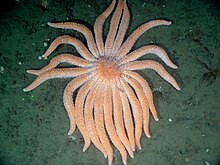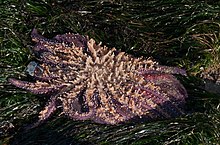Pycnopodia helianthoides
| Pycnopodia helianthoides | ||||||||||||
|---|---|---|---|---|---|---|---|---|---|---|---|---|

Pycnopodia helianthoides in a tide pool, Northern California |
||||||||||||
| Systematics | ||||||||||||
|
||||||||||||
| Scientific name of the genus | ||||||||||||
| Pycnopodia | ||||||||||||
| Stimpson , 1862 | ||||||||||||
| Scientific name of the species | ||||||||||||
| Pycnopodia helianthoides | ||||||||||||
| ( Brandt , 1835) |


Pycnopodia helianthoides , also sunflower starfish , is a species of starfish from the order of the pincer stars (Forcipulata) with numerous arms, which is common on the North American Pacific coast . With a wingspan of up to one meter, it is one of the largest starfish in the world. Outwardly it resembles the sun stars , but belongs to the Asteriidae family. Due to the overheating of the habitat as a result of climate change and a virus, the species is currently affected by mass extinction.
features
Pycnopodia helianthoides usually has 16 to 24 arms about 40 cm long and reaches a diameter of mostly 80 cm, sometimes up to 1 m and a body mass of about 5 kg. The color of the rather soft, velvety structured skin on the upper side varies greatly between light orange, yellow and red to brown and sometimes purple. The approximately 15,000 yellow to orange-colored suction feet on the light-colored underside of the animal achieve such a high force when sucking on the rock that they tear rather than detach from the ground.
Reproductive cycle
Pycnopodia helianthoides is segregated and can reproduce asexually through fissiparia as well as sexually. In May and June, numerous females and males come together, use their arms to straighten their central disc and release their germ cells into the open sea, where the egg cells are fertilized by the sperm. Larvae that swim freely develop as plankton and feed on phytoplankton near the sea surface . After 2 to 10 weeks, the larvae anchor themselves on the seabed and undergo metamorphosis into starfish, which initially only have five arms. In the weeks that followed, they grew more arms. Pycnopodia helianthoides can live 3 to 5 years.
Distribution and occurrence
Pycnopodia helianthoides is on the North American Pacific coast from the Aleutian Islands to San Diego in California often, with the largest individuals in Puget Sound ( British Columbia ) and Alaska can be found. The starfish live in the lower intertidal zone and below in areas with a lot of seagrass and seaweed , but cannot tolerate lying in the dry for longer.
nutrition
Pycnopodia helianthoides largely prefers sea urchins as prey, but also often eats starfish , sea cucumbers , mussels , snails (including abalones ), crabs ( barnacles , hermit crabs ) or carrion .
With speeds of around 1 m / min, Pycnopodia helianthoides is one of the fastest starfish and can overtake a number of prey. Due to the limestone plates that are not connected to one another, the starfish can also devour larger prey, but when the prey is very large it turns its stomach out for extraintestinal digestion .
Predators
The main predators of Pycnopodia helianthoides include various fish , king crabs and sun stars (especially Solaster dawsoni ). To save itself, the starfish often autotomically sheds one or more arms, which grow back in a few weeks.
literature
- Howard M. Feder: Asteroidea , in: Robert Hugh Morris, Donald Putnam Abbott, Eugene Clinton Haderlie: Intertidal Invertebrates of California . Pp. 117-135, here p. 127, 8.16: Pycnopodia helianthoides (Brandt, 1835) . Stanford University Press, 1st ed., Stanford (CA, USA) 1980.
- Philip Lambert: Sea Stars of British Columbia, Southeast Alaska, and Puget Sound . Royal British Columbia Museum, University of British Columbia Press, Vancouver 2000. Pycnopodia helianthoides , pp. 139-142.
Web links
- Shayna Yagoda: Pycnopodia helianthoides . Animal Diversity Web, 2004.
- Scott Boyd (Boydski): Sunflower Sea Star (Pycnopodia helianthoides) . Emerald Sea Scuba, LLC, 2015.
- Sunflower Star . Channel Islands National Park, National Park Service.
- Sunflower Star . North Island Explorer.
- Sunflower sea star (Pycnopodia helianthoides) - NOAA
Individual evidence
- ↑ CD Harvell et al. a. (2019). Disease epidemic and a marine heat wave are associated with the continental-scale collapse of a pivotal predator (Pycnopodia helianthoides). Science Advances , 5 (1), eaau7042. https://doi.org/10.1126/sciadv.aau7042


